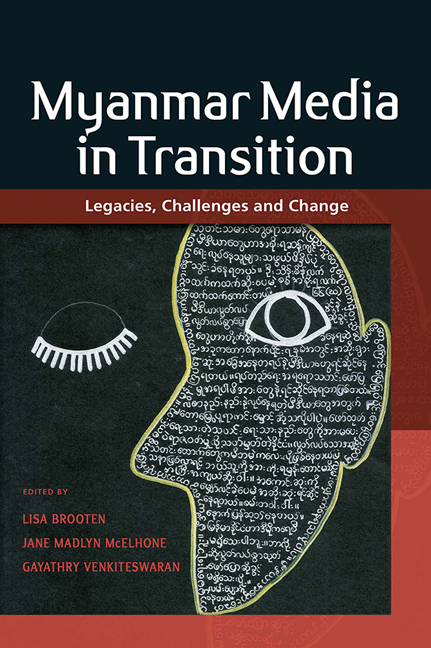Book contents
- Frontmatter
- Contents
- Contributors and Editors
- Burma or Myanmar? A Note on Terminology
- 1 Introduction: Myanmar Media Historically and the Challenges of Transition
- Part I Structural Constraints and Opportunities
- Part II Journalism in Transition
- 6 Silencing a Snakehead Fish: A Case Study in Local Media, Rural-Based Activism, and Defamation Litigation in outhern Myanmar
- 7 Precarity and Risk in Myanmar's Media: A Longitudinal Analysis of Natural Disaster Coverage by The Irrawaddy
- 8 Educating a New Generation of Watchdogs: Interview with Ye Naing Moe, Director of the Yangon and Mandalay Journalism Schools
- 9 The Metamorphosis of Media in Myanmar's Ethnic States
- 10 Covering Rakhine: Journalism, Conflict and Identity
- 11 Media in Myanmar: Laws, Military and the Public
- 12 Cracking The Glass Ceiling in Myanmar Media
- 13 Media and the 2015 General Elections
- Part III Creative Expression
- Part IV Society and Media
- Epilogue: Media Studies in Myanmar – Where Do We Go from Here?
- Index
11 - Media in Myanmar: Laws, Military and the Public
from Part II - Journalism in Transition
Published online by Cambridge University Press: 07 September 2019
- Frontmatter
- Contents
- Contributors and Editors
- Burma or Myanmar? A Note on Terminology
- 1 Introduction: Myanmar Media Historically and the Challenges of Transition
- Part I Structural Constraints and Opportunities
- Part II Journalism in Transition
- 6 Silencing a Snakehead Fish: A Case Study in Local Media, Rural-Based Activism, and Defamation Litigation in outhern Myanmar
- 7 Precarity and Risk in Myanmar's Media: A Longitudinal Analysis of Natural Disaster Coverage by The Irrawaddy
- 8 Educating a New Generation of Watchdogs: Interview with Ye Naing Moe, Director of the Yangon and Mandalay Journalism Schools
- 9 The Metamorphosis of Media in Myanmar's Ethnic States
- 10 Covering Rakhine: Journalism, Conflict and Identity
- 11 Media in Myanmar: Laws, Military and the Public
- 12 Cracking The Glass Ceiling in Myanmar Media
- 13 Media and the 2015 General Elections
- Part III Creative Expression
- Part IV Society and Media
- Epilogue: Media Studies in Myanmar – Where Do We Go from Here?
- Index
Summary
There are two views in our country on how to develop the media. One is that we need to prioritize proper media legislation. The other is that we need to change our mindsets.
In Myanmar there are times when the military respects the law, and there are other times when it uses the law to protect itself. Take, for instance, my arrest on 26 June 2017 in northern Shan State while I was doing my job — reporting on the war.
Before this incident I had often travelled to northern Shan State for the same purpose — to cover armed conflict — but I had never before faced arrest. In November 2016 there were clashes between the Northern Alliance of ethnic armed groups and the military. This happened in the northern Shan State townships of Mong Ko, Muse and Kutkai. When I travelled to Muse there were several army checkpoints between Kutkai and Namkham. At each checkpoint, soldiers checked my phone and my wallet. On my phone they looked to see whether I had taken photos with the rebels. In my wallet they checked if I had contact information for the rebels. If I had had those things, I would have been detained. But each time they let me go, because I did not have anything incriminating. At one checkpoint an army officer asked me whether I was a conflict reporter. I told him that I was and he said that I could accompany his troops to the front line. But once he understood that I would take him up on the offer, he told me that it would be a long process to inform the top officials and to get permission. It did not happen.
According to the law, I have the right to travel to the conflict areas. But when I was arrested in 2017 the army accused me of not having permission to be there. We have laws, but these laws are not always respected. Those who focus on improving media legislation in Myanmar need to remember that laws are not always followed here. Laws should not favour one side. They should protect everyone in the country, and be applied equally.
- Type
- Chapter
- Information
- Myanmar Media in TransitionLegacies, Challenges and Change, pp. 239 - 242Publisher: ISEAS–Yusof Ishak InstitutePrint publication year: 2019

